Before winter, not every gardener dares to plant flowers on a plot. But those who have already tried, know for sure that it is profitable and convenient. One of the reasons is good soil moisture, which significantly reduces watering and care after sowing. It is also worth considering that at the end of autumn the garden is much less trouble, so it's time to pay attention to flower beds and flower beds, so that in the first warm days to enjoy the first flowering. In October-November, you can plant both perennial and annual flowers, it is better to choose varieties that are most adapted to frost or require stratification.
Content
Pros and cons of winter crops
Winter sowing has many advantages, although starting a planting is worth knowing the disadvantages to be prepared for the unexpected. There are several advantages because of which gardeners sow flowers in the winter:
- If in the fall you do not need to be planted in the ground, then with the onset of heat, you will have to prepare the soil, fertilize, moisten, and wait for the temperature to be set so that the frost does not damage the sprouts. In addition to flowers, gardeners devote a lot of time to vegetables, shrubs, trees, because they all require care, so things may not come to beauty in the flowerbed.
- Seeds that have wintered in the ground become more hardened, so some varieties are able to cope with spring cooling without loss. Many cultures need stratification, so it’s easier to plant them in the ground than to keep them in the refrigerator all winter, artificially maintaining the “natural” conditions.
- With autumn sowing, you will not need to plant seedlings on the windowsills and then plant them in the ground (there is a category of lovers who are not difficult to do, but some would gladly refuse this process).
- Early shoots. Sometimes it is 2-3 weeks earlier than spring plantings. And when the heat is just beginning, everyone is tired of the cold, damp, gray, a bright flower bed will be a great occasion for joy and good mood.
The minuses include:
- the probability of germination in the event of sharp warming in the fall or winter with a plus temperature (if the seeds have time to germinate, then they will die during a cold snap);
- not all seed will sprout, so you will have to sow 20-30% more than in spring;
- some perennials bloom only in the second year.
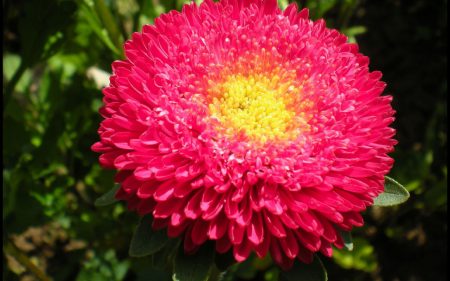 You may be interested in:
You may be interested in:What flowers can be sown before winter
From the end of August until the first days of December, you can plant seeds, bulbs, or plant bushes. It can be both annual and perennial varieties, the main thing is that they can tolerate cold. Bulb lovers should take care of the preparation in advance by selecting and drying the strongest bulbs.Before starting, it is worthwhile to properly prepare the soil, take into account the location of the flowerbed and choose the optimal period so that the seeds do not die due to early planting. It is better not to drag out the bushes, they need time to take root, so September is great for this. For most seeds, the best period is October. With onions, everything is individual, for example, muscari can be planted in the ground already at the end of August. Winter sowing of asters is carried out in late October or early November.
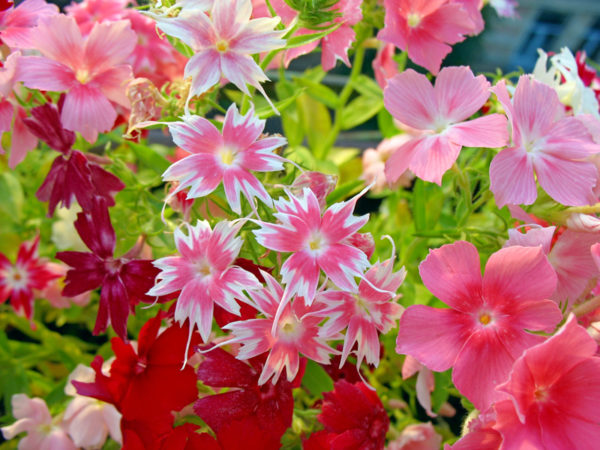
The criterion for the optimal time for sowing seeds is when the temperature does not rise above zero either day or night. In some regions, this occurs already in mid-November, in the southern - in December. The main thing to consider is the climate, so that the seedlings do not appear at the time of warming, if they are planted too early. If the beds are prepared in advance, then you can add seeds in December and even in January. If the soil is already freezing, use either a school or pre-prepared containers and beds for sowing.
Autumn sowing of annuals
Annual crops are necessarily planted in frozen ground, otherwise they can sprout and die during the onset of cold weather. Seeds are placed in grooves prepared in advance, sprinkled with a substrate, leaves, peat. After emergence, they must be thinned out.
You can sow in the snow in December, in January, with a snow cover of at least 25 cm. Then the grooves are no longer done, just throw the seeds into the snow. So that they would not be carried away by the wind, the birds would not glue, or they would not freeze, trample the snow, lay a layer of soil mix or peat on top, and additionally sprinkle with snow. The soil must be prepared in advance - when it is still warm, they dig it up, fertilize it.
Annual varieties are not often sown before winter, because they germinate well in the spring and bloom immediately abundantly. If you choose those that sprout well in the spring, then these are cornflowers, marigolds, marigolds, fragrant tobacco, matthiola, chrysanthemums, annual asters, scabiosis, poppy, and reseda. To make the flowering earlier, after the snow melts, they set arcs and pull the film so that they ascend faster. It is better to choose a permanent place immediately, annuals do not need to be transplanted. You can also sow flower beds in the winter:
- agrostemma;
- Adonis;
- godetia;
- kohiyu;
- dimorphic library;
- Damascus Nigella
- Lavater
- sea alissum;
- Chinese cloves;
- kosmey;
- clarkia marigold;
- antirrinum;
- malcolm seaside;
- phrum Drummond;
- eshsoltsiyu.
Perennial autumn sowing
Of perennials, first of all, you need to plant onions, during the winter some small onions dry out and by the spring already become unsuitable for sowing. If you still didn’t have time in time, you can leave them for distillation or arrange suitable storage conditions until spring.
In autumn, perennial shrubs with a closed root system take root better; they are able to withstand frosts if they are covered. An open root system needs more time to adapt, so it’s best to plant them early. In some cases, it is better to tuck in the seedlings, covering it with film or branches, so that in spring to determine a permanent place for them.
When the snow comes down, it is better to cover the beds with foil to accelerate growth and protect against birds, spring rains and sudden night frosts. When shoots appear, the film is removed and after 15 days shoots are dived, depending on the species.
Such perennials are planted in autumn:
- arabis;
- gaillardia;
- doronicum;
- shave
- lavender;
- aconite;
- Buzulnik;
- heicher;
- to the center;
- rudbeckia;
- daisy;
- aquilegia;
- primrose;
- doronicum;
- spurge;
- yarrow.
How to sow seeds before winter
In addition to the usual method of planting in open ground, you can use two more - in the school and in the tank. Which one to choose for yourself depends on the climate, period, variety, readiness of flower beds. In some suburban areas, free space is not entirely suitable for winter sowing. Usually this happens where there are small slopes along which meltwater flows in the spring. If the snow cover is high, then these streams will wash away the immature seeds, nullifying all efforts.
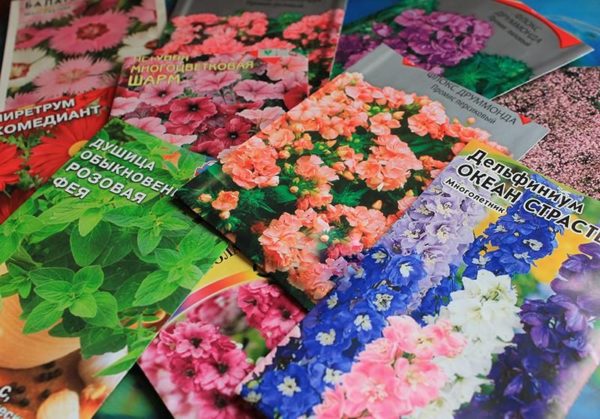
In open ground
Flowers for winter sowing that do not tolerate transplanting, it is better to plant immediately in open ground. This is especially true for crops with a rooted root system. These include - magnolias, star anise, Californian poppy, purple sarracenia, wild begonia, sea armeria, oleander, bindweed, lavender officinalis, Tuscan bellflower, calendula, European aster, Korean chrysanthemum, dahlia.
It is better to plant seedlings with roots in warm time, so that the roots have time to strengthen, but the seeds are thrown into the already frozen ground so that they do not sprout ahead of time. Top must be covered with a layer of humus, peat or topsoil, which is removed a little earlier, and stored until sowing in a warm place. Bulbs deepen by about 2 lengths of their size, the seeds should not be left deep, otherwise in the spring they will sprout for a very long time.
 You may be interested in:
You may be interested in:It is better to prepare a flower bed in advance - in the spring or in the summer. The site is dug up, fertilized with phosphorus and potash fertilizers. No need to make nitrogen supplements that provoke activity, helping rapid growth; winter planting does not imply seedlings before spring.
Sowing seeds to school
The school is a separate small bed for seedlings, regrowth of cuttings, support of plants with different germination periods and conditions. For its arrangement, the southern section on a hill is better suited. Height - 20 cm, then the soil warms up faster and is not exposed to the risk of leaching seeds with melt water when snow melts. Land preparation begins in mid-September - they fertilize, loosen, if necessary, bring river sand, humus, crushed stone. The top layer is leveled, compacted, deepened, depending on the size of the seed. The larger the seeds or bulbs, the deeper the grooves are made, usually not deeper than 4 cm. After that, they cover with a film so that the snow that has fallen does not disturb the structure of the bed, and it can be planted even under snow.
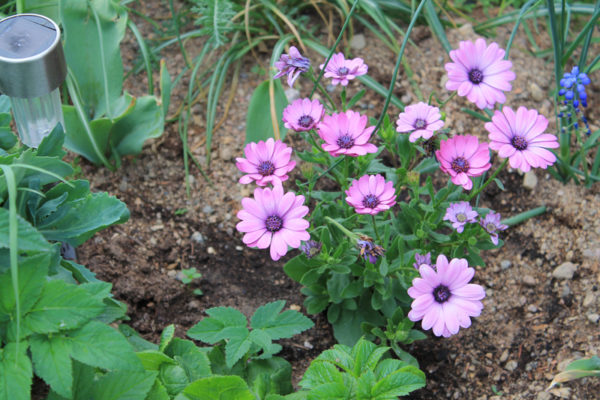
By the end of October, you can start sowing. The film is removed, the seeds are put in the wells several pieces at once, in case not all sprout. Small ones are put a little more, large ones are enough 2-3, it all depends on the variety and their size. Top with a soil mixture, which is prepared in advance and kept in a warm place. To do this, mix humus, peat, sand. You can also add fallen leaves, dry grass to insulate. Autumn sowing does not need watering, otherwise the plants will begin to develop ahead of time.
After the snow melts, the top layer of mulch is removed and waiting for seedlings. As soon as strong sprouts with two leaves appear, you can thin out the landing if the shoots are plentiful. After 14 days, you can repeat the procedure if the sprouts interfere with each other.
Sowing seeds in a container
As containers, most often use pots of different diameters from 7 to 10 cm with drainage holes.They should not be easily deformed and bent, otherwise the roots can be damaged.
It is better to take a loose substrate that will not allow moisture and air to pass through, but will allow small roots to sprout. To do this, mix peat, sand, earth in a ratio of 3: 3: 1. Before applying the seeds, it is slightly moistened.
Drainage - expanded clay, small fragments of bricks, small pebbles with a layer of 2 cm is laid at the bottom, then the prepared mixture is poured, leaving about 1.5-2 cm of free space on top, compacted. Lay the seeds, watered.
Ready-made containers with seed are placed on the site in well-lit, sheltered from the wind, places. They are installed in pits 30 cm deep, in which drainage is also laid on the bottom. The edges should neither protrude nor deepen much. Between the pots, dry grass is poured, leaves are covered with mulch.

When the snow finally melts, the upper layer of the shelter is removed, after emergence, thin out. Plants are transferred to flower beds only by the end of May, beginning of June, depending on the climate.
What is important to do in spring
In spring, the earth must be moistened so that the seeds do not dry out, the less snow there is, the more watering will be required. After the snow melts, the film is laid on the beds or pulled on arcs. This will accelerate the emergence of seedlings and protect against wind, birds and colds.
After the emergence of the shoots, the shelter is removed, thinned out, and, if necessary, seated. If part of the seeds has not germinated, additionally seeded so that there are no empty spaces or too wide gaps between the bushes on the flower beds. Every 15 days, check the density of the shoots, removing the excess, taking into account the size of the stem and the distance between the flowers. When using schools and containers, the grown seedlings are transferred to a permanent place as soon as they get stronger and the weather becomes warm.
Place for winter sowing flowers
It is very important to choose a good place for flowers, so that adverse factors minimally affect germination and development. Melt water, strong wind, scorching rays of the sun - all this can interfere with seedlings, therefore, based on the selected varieties, you need to choose the site with the most favorable location, taking into account all the interference.
Too acid or clay soils become denser during the winter, so in the spring the sprouts will not be able to break through the dense upper layer. To fix this, in the autumn you need to make sand, gravel or peat, loosen to lighten the soil a little. Fertilizers are applied with potassium and phosphorus. Mulch, which is covered from above and the top layer of the earth must be kept in a warm place so that they are not frozen at the time of sowing.
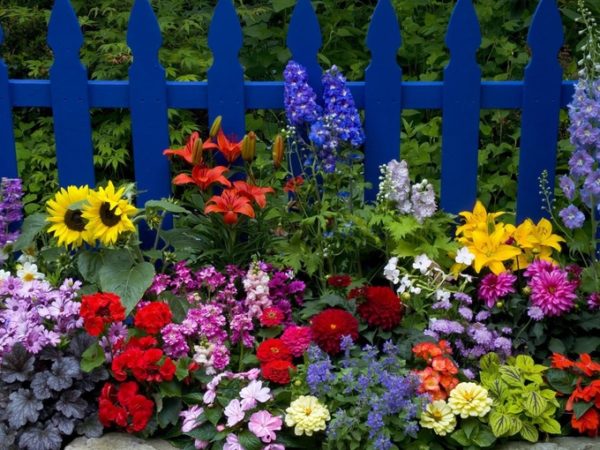
Preparing beds for winter sowing flowers
Sowing sown in the fall, it is better to place where the early work is not carried out in the spring. Before starting, the remains of weeds are carefully harvested so that they do not germinate, and do not interfere with young shoots. Compost is not introduced, because of the likelihood of residues in it that have not yet decayed the roots of harmful plants. The ground is leveled, grooves or holes are made 1-1.5 cm deep. Stakes with labels can be placed on the sides of the rows, on which the sowing date and the name of the variety are written. It is better to dig them in advance, because it will not work to stick them into the frozen ground.
You can install arcs on which a film is pulled or a piece of linoleum is laid. This will come in handy before sowing, if suddenly snow falls early, and in the spring, in case of early frosts.
Soil for winter sowing flowers
It is ideal to use a ready-made mixture from gardening, prepared taking into account the varieties that will grow there.If this is not possible, or the soil on the site is suitable, you need to collect the top layer in advance in a bag and put in a barn or house so that it does not freeze. It is enough to use it only for powdering, even if the ground is frozen, the seeds are thrown from above, and then covered with a prepared warm substrate.
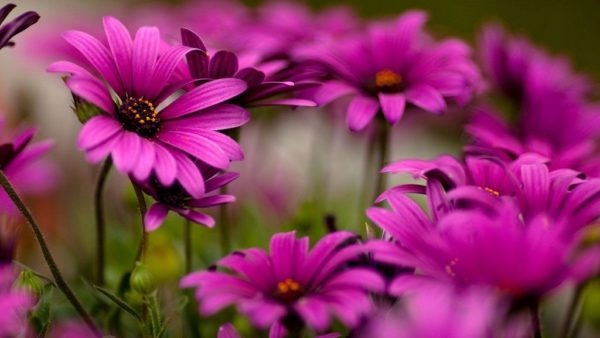
Conclusion
For autumn sowing, you need to carefully select crops, so as not to waste time, and not to be upset in the spring, when the flower bed does not bloom, remaining empty. It is better to take those seeds that are resistant to cold or must pass stratification. It is also worth planting those varieties that have a short shelf life, if stored for a long time, then germination is greatly reduced. Before planting, you can check all your stocks, so as not to forget about those that have been lying for more than one season, it is also better to sow these before winter, so that in the spring you can add fresh ones if they do not sprout.
Some varieties perennials bloom only in the second year, this should be taken into account before sowing, and when choosing a place so that there is no empty space in the flowerbed or rock garden. Such plants are planted either separately or with those that open their flowers at the same time as them.
Planting dates can be even the latest - the main thing is to ensure that warming does not begin in the coming days after planting. The beds are prepared in advance, leaving the top layer of earth and mulch in a warm place, which will be sprinkled on top. They put a little more seeds in the holes than in the spring, in case some do not tolerate the cold.

 10 beautiful annuals that bloom all summer
10 beautiful annuals that bloom all summer Sow in the ground, without seedlings: 10 beautiful and unpretentious flowers
Sow in the ground, without seedlings: 10 beautiful and unpretentious flowers Platicodon planting and outdoor care
Platicodon planting and outdoor care Hosta - planting and care in the open ground in the Urals
Hosta - planting and care in the open ground in the Urals